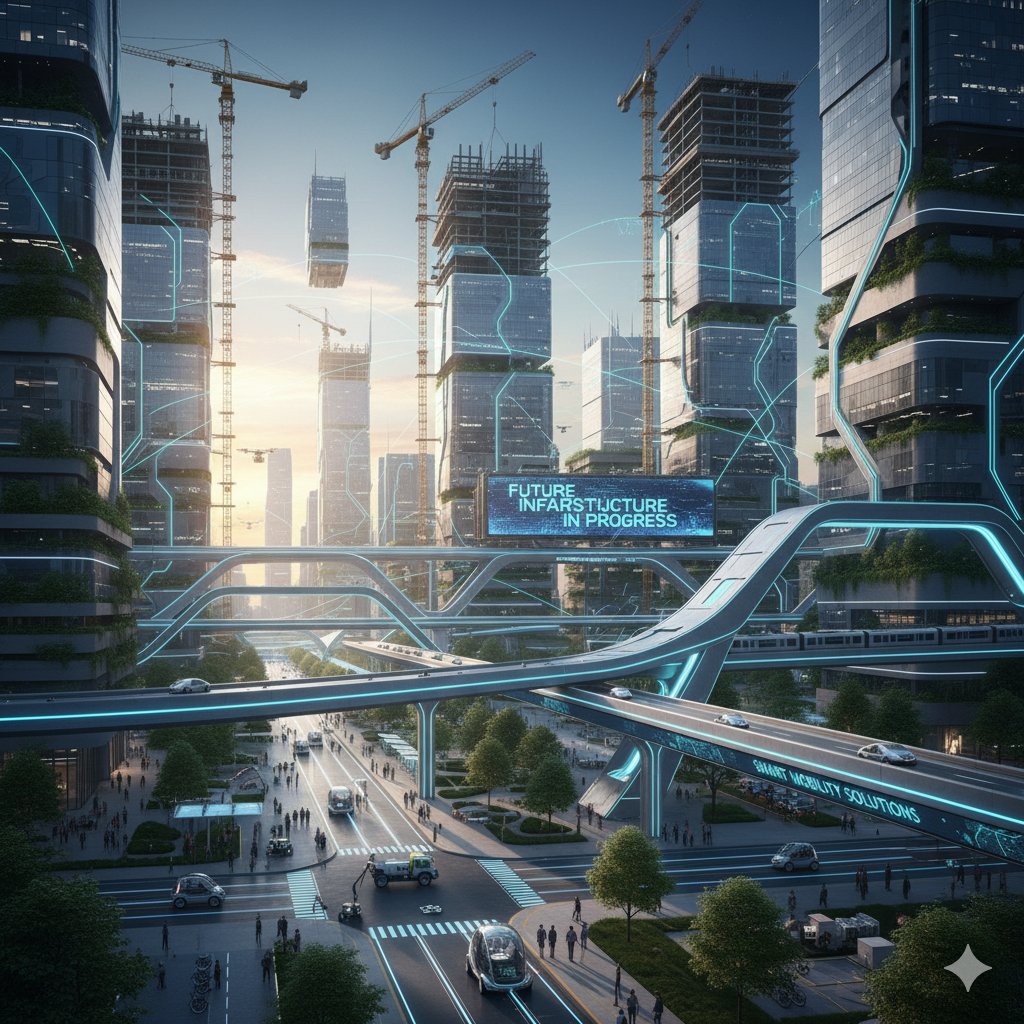Our planet’s cities are at a critical juncture. They are the vibrant hearts of innovation, culture, and commerce, but they are also the epicenters of our climate challenge. Urban areas consume over two-thirds of the world’s energy and account for more than 70% of global CO2 emissions. Simultaneously, these dense landscapes of concrete and asphalt are uniquely vulnerable to the impacts of climate change, from flash floods to scorching heatwaves.
For decades, the answer to urban challenges was “grey” infrastructure: a complex system of concrete pipes, sewers, sea walls, and treatment plants. While essential, this approach is rigid, expensive to maintain, and often overwhelmed by the new extremes of a changing climate.
A more elegant, effective, and sustainable solution is taking root. Enter Green Infrastructure (GI), a transformative approach that weaves natural systems back into the urban fabric. This is not merely about planting trees or creating parks; it is a strategic, interconnected network of nature-based solutions designed to build cities that are both low-carbon and climate-resilient.
What is Green Infrastructure? A Living, Multifunctional Network
Green infrastructure mimics and harnesses the power of natural processes to solve urban problems. Unlike a “grey” pipe built only to move water, a single GI installation can manage stormwater, cool the air, improve public health, and sequester carbon—all at the same time.
It’s best understood as a multi-layered network operating at every scale:
- At the Building Level:
- Green Roofs: Layers of vegetation planted on rooftops that absorb rainwater, insulate buildings (reducing energy use), and combat the urban heat island effect.
- Living Walls: Vertical gardens that insulate buildings, filter air pollutants, and provide cooling.
- Rain Barrels: Simple systems that capture roof runoff for later use in irrigation.
- At the Neighborhood Level:
- Bioswales: Vegetated channels designed to slow, filter, and absorb stormwater runoff from streets and parking lots.
- Permeable Pavements: Surfaces for sidewalks, driveways, and parking lots that allow rainwater to soak through into the ground, recharging groundwater instead of flooding sewers.
- Urban Tree Canopy: Strategically planted trees that provide shade, intercept rainfall, and filter air pollution.
- At the City Level:
- Constructed Wetlands: Engineered ecosystems designed to receive and treat stormwater or wastewater naturally.
- Greenways and Corridors: Networks of protected green space that connect parks and habitats, providing corridors for wildlife and recreational routes for people.
- Urban Forests: Large, managed areas of trees that act as the “lungs” of a city.
The true power of GI lies in its multifunctionality. It is the sustainable pathway to addressing our two most pressing urban challenges: high emissions and climate vulnerability.
The Pathway to a Low-Carbon City
Green infrastructure is a critical tool for climate change mitigation, actively reducing the carbon footprint of a city in three fundamental ways.
1. Direct Carbon Sequestration The most direct benefit comes from the plants themselves. Through photosynthesis, the trees, shrubs, grasses, and soil organisms that make up green infrastructure act as “carbon sinks.” They pull carbon dioxide (CO2) from the atmosphere and store it in their biomass (trunks, roots, and leaves) and in the soil. An established urban forest or a healthy wetland can lock away significant amounts of carbon, helping to offset the city’s emissions.
2. Slashing Energy Consumption Perhaps the most powerful impact of GI is its ability to reduce a city’s energy demand, particularly for cooling.
Urban areas suffer from the “Urban Heat Island” (UHI) effect. Dark surfaces like asphalt roads and concrete buildings absorb solar radiation and re-radiate it as heat, making cities several degrees hotter than surrounding rural areas. This triggers a vicious cycle: hotter cities require more air conditioning, which consumes vast amounts of electricity, which in turn leads to more emissions from power plants.
Green infrastructure breaks this cycle. Trees provide direct shade, preventing surfaces from absorbing heat in the first place. Through a process called evapotranspiration, plants and water bodies release moisture into the air, acting as giant, natural air conditioners. A mature urban tree canopy can lower ambient temperatures, reducing cooling needs in nearby buildings by up to 30% and cutting city-wide energy demand for cooling significantly.
3. Promoting Sustainable Mobility GI development is not just about static installations; it’s about creating a more livable environment. Well-designed greenways, shaded cycling paths, and cool, walkable pedestrian corridors actively encourage people to leave their cars at home. By making walking and biking safer and more pleasant, cities can directly reduce emissions from transportation, a major source of urban pollution.
Forging a Climate-Resilient City
If “low-carbon” is about stopping future damage, “resilience” is about surviving and thriving despite the damage that is already locked in. Green infrastructure is our best defense for adapting to climate extremes.
1. Taming the Floods: Masterful Stormwater Management The “concrete jungle” is largely impermeable. When intense rain hits, water has nowhere to go. It sheets off roofs and roads, overwhelming sewer systems and causing destructive flash floods.
Green infrastructure turns the city from a concrete shield into a living sponge.
- Permeable pavements and bioswales capture rainwater where it falls.
- Rain gardens and wetlands slow the water down, filter out pollutants (like oil and heavy metals from roads), and allow it to infiltrate harmlessly into the ground.
This natural “slow, spread, and soak” approach is a game-changer. It reduces the peak volume of water rushing into grey sewer systems, preventing overflows that pollute rivers and lakes. It also recharges groundwater aquifers, which is vital for drought resilience.
2. Surviving the Heat: Cool Refuges for Public Health Intense heatwaves are no longer a rare anomaly; they are a dangerous new normal. The same UHI-busting properties that reduce energy use also save lives. Green roofs, living walls, and shaded parks create “cool refuges” within the city, providing critical relief for vulnerable populations and reducing the incidence of heat-related illness and death.
Beyond Carbon and Climate: The Co-Benefits
The beauty of green infrastructure is that its benefits ripple out, creating a cascade of positive outcomes that make cities richer, healthier, and more equitable.
- Economic Benefits: GI is a smart investment. It is often cheaper to install and maintain than large-scale grey infrastructure projects. It increases property values, reduces municipal costs for energy and water treatment, and creates thousands of local “green jobs” in design, construction, and maintenance.
- Health and Social Benefits: Access to green space is directly linked to improved mental and physical health. It reduces stress, lowers blood pressure, and encourages physical activity. Green infrastructure also filters air pollutants like particulate matter and nitrogen oxides, leading to better respiratory health for all residents.
The Pathway Forward: From Concept to Reality
Implementing green infrastructure at a city-wide scale requires a shift in thinking. The pathway forward involves:
- Policy Integration: Cities must embed GI into their very DNA, updating zoning laws, building codes, and public works standards to make green solutions the default, not the exception.
- Innovative Financing: Moving beyond traditional bonds, cities are using public-private partnerships and “stormwater utility fees”—where properties pay a fee based on their impermeable surface area—to fund GI projects.
- Smart Integration: The future is “blue-green-grey.” The newest innovations integrate GI with smart technology—like soil moisture sensors in bioswales or digital twins of urban watersheds—to optimize performance and maintain these living systems effectively.
- Community Stewardship: Engaging residents in the design and care of local GI projects, from community gardens to neighborhood rain gardens, builds a sense of ownership and ensures long-term success.
Green infrastructure is no longer a niche concept or a decorative add-on. It is fundamental, essential, and a cost-effective pathway to the cities of the future—cities that are not just smart, but living, breathing, low-carbon, and resilient.


